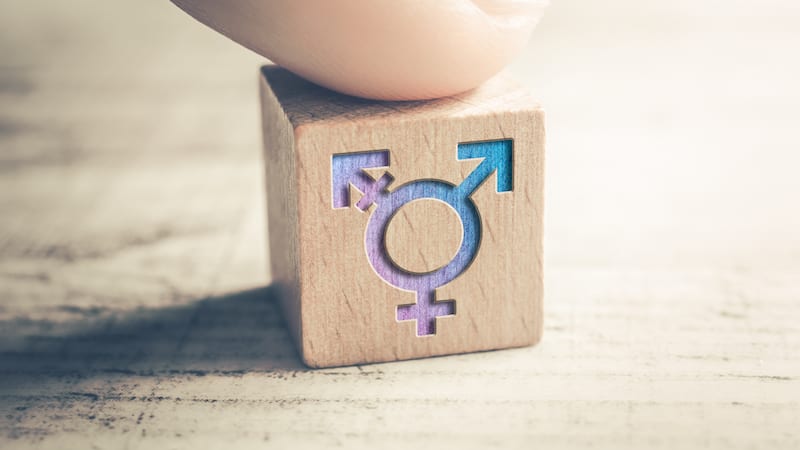As a trans non-binary educator, I grew up not seeing myself represented in curriculum, media, or the world around me. I felt invisible and did not believe there was a place for me in the binary society that surrounds us. As an adult, I was able to find the words and representation where I saw and embraced my identity. Now, realizing how powerful that representation is, I work to bring visibility and support gender-nonconforming and transgender in the elementary classroom.
Currently, though, the existence of trans youth is under attack. There are over 100 bills across the states that are pushing to ban trans youth from living authentically. Of those bills, over 45 are state legislative bills. The bills focus on stopping trans youth from receiving gender affirming healthcare, participating in sports, and less protections around youth being out and safe in public spaces. The language in many of these bills implies that being transgender is dangerous, that transphobic language and misgendering are acceptable, and criminalizes medical care for our trans kids across the United States.
The attack of these bills is not a coincidence. These are timed attacks against the trans community; specifically against trans youth. Learners as young as three can determine what their gender identity is, but many times our places of learning are not safe spaces for our trans and gender non-conforming kids.
Trans and Gender Nonconforming Statistics
Currently, 10 percent of LGBTQ youth reported undergoing conversion therapy, with 78 percent reporting it occurred when they were under age 18 (Trevor Project National Survey, 2020). Sixty-one percent of transgender and nonbinary youth reported being prevented or discouraged from using a bathroom that corresponds with their gender identity. From the same survey, 40 percent of transgender and nonbinary youth reported being physically threatened or harmed due to their gender identity.
Although these statistics may be alarming, they are not surprising. As educators, caregivers, and people that work with youth each day, how can we support trans and gender nonconforming youth on a day-to-day basis? How can we combat the ongoing transphobia?
First, whether you are aware if you have a trans or gender nonconforming student in your class or not, we all must work on normalizing being queer. It is vital we make space in our classrooms to normalize all genders and identities. Each of our communities is different places in this, but that doesn’t mean we can not begin to have these discussions, read inclusive stories, or introduce personal pronouns.
[contextly_auto_sidebar]
Do Your Own Unlearning
As learners ourselves, it may be hard to know where to start and how to start. The best thing to start with is learning and unpacking your own biases and misunderstandings around a topic. Consider the following resources:
- Dispelling Six Myths About Transgender Identity
- Trevor Project: A Guide to being an Ally to Transgender and Nonbinary Youth
- GLAAD Transgender FAQ
- Guide for Supporting Trans Students at School
Representation Matters
As our libraries grow to include all voices, make sure you include trans and gender nonconforming voices in your library. There are a variety of picture books and chapter books that not only center trans and gender nonconforming characters, but many books are #ownvoices, too! These can be used in lessons as read alouds or just options for reading in and out of the classroom.
Below is a list of some fantastic books that includes a variety of queer books from young children to adult. (Note, WeAreTeachers may collect a share of sales from these links.)
- When Aiden Became a Brother by Kyle Lukoff
- Phoenix Goes to School Book by Michelle Finch and Phoenix Finch
- Call Me Max by Kyle Lukoff
- Neither by Airlie Anderson
- My Rainbow by DeShanna Neal and Trinity Neal
- It Feels Good to Be Yourself by Theresa Thorn
- They, She, He, Me: Free to Be by Maya Christina Gonzalez
- Julian is a Mermaid by Jessica Love
- Annie’s Plaid Shirt by Stacie B Davids
- Peanut Goes for Gold by Jonathan Van Ness
- Gracefully Grayson by Ami Polonsky
- George by Alex Gino
- The Pants Project by Cat Clarke
Find more book recommendations at LGBTQIA+ Book List . Also, check out our #ownvoices fiction and #ownvoices nonfiction lists.
Include Transgender History
Transgender people have been in history for centuries. No matter what history you are teaching, work to include transgender and gender nonconforming folx in your history and discussions. Include current transgender and gender nonconforming folx when discussing current politics, sports, or activism. This can be done in younger elementary all the way to secondary. Work to dive into history and bring transgender folx to the forefront.
Here are some resources to begin that process:
- 7 Transgender History Books to Read
- Digital Transgender Archive
- LGBTQ+ Trailblazers from GLSEN
- Queer Portraits in History
Teaching Personal Pronouns
When we talk about teaching pronouns, many people still think about teaching pronouns from a grammatical standpoint. While this is still critical and part of the standards, there are other ways we can be and should be teaching pronouns. One of the best ways to introduce pronouns is starting with the book mentioned above: They, She, He, Me: Free to Be! By Maya Christina Gonzalez. We can not only integrate it in a morning meeting practice or discussion, but it can be part of an ELA or history lesson or even integrated into a math problem. This is not only a way to teach respect and inclusivity, but it normalizes different pronoun use each day. A great way to practice pronouns and introducing ourselves with pronouns is to have a stuffed animal or mascot where you can practice!
Making An Inclusive Space
Just by doing one or two of these things, you will begin to create a space that combats transphobia and is a place of inclusivity for all queer youth. It will not only show others how to care and respect each other and their identity, but also show transgender and gender nonconforming youth that they matter. It will show them that they are seen even if it is something as small as reading a book. As we begin to do these little things in our classrooms, we can work to combat the ongoing transphobic narrative that is working to harm our trans and gender nonconforming youth.
How do you help support transgender students and curriculum in the classroom? Share in the comments below.
Want more articles like this? Make sure to sign up for our newsletters.


